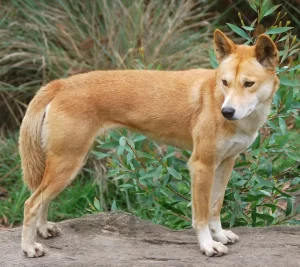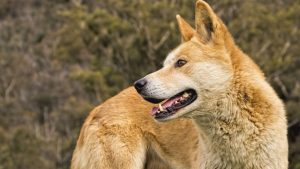Basic information about Dingo Dogs
Dingoes are wild canines native to Australia, and they are considered a distinct species from domestic dogs. However, they are often referred to as “dingo dogs” due to their resemblance to domestic dogs and their close genetic relationship. Here’s an overview of dingoes:
Appearance
Dingoes vary in appearance but typically have a lean and athletic build, well-suited for their role as apex predators in the Australian ecosystem.
They have a short, dense coat that can range in color from sandy yellow to reddish-brown, with white markings on the chest, paws, and tail tip being common.
Dingoes have erect ears, a bushy tail, and a pointed muzzle. They often have a keen and alert expression, reflecting their intelligence and adaptability.
Behavior
Dingoes are highly adaptable and resourceful animals, capable of thriving in a variety of habitats, including forests, grasslands, and deserts.
They are skilled hunters and scavengers, preying on a wide range of animals, including kangaroos, wallabies, rabbits, and rodents. They may also scavenge carrion or hunt smaller prey like birds and reptiles.
Dingoes are generally solitary animals or live in small family groups known as packs. They are territorial and may defend their territory from intruders, including other dingoes or domestic dogs.

History
Dingoes are believed to have arrived in Australia thousands of years ago, likely originating from domestic dogs brought by early human settlers or introduced independently to the continent.
Over time, dingoes adapted to the Australian environment and evolved into a distinct species, distinct from both domestic dogs and wolves.
Dingoes have played a significant role in Aboriginal culture and mythology, featuring prominently in Indigenous Australian stories and art.
Conservation Status
Dingoes face numerous threats in the wild, including habitat loss, competition with introduced species, and persecution by humans.
In some areas, dingoes are considered pests and are subject to control measures such as trapping, shooting, and poisoning to protect livestock and native wildlife.
Efforts to conserve dingoes and their ecological role have sparked debate, with some advocating for their protection as a native species and others calling for their control to mitigate conflicts with humans and domestic animals.
Is it legal to raise a Dingo?

The legality of raising a dingo varies depending on the region and local laws. In many places, including Australia, dingoes are protected wildlife, and it may be illegal to capture, possess, or raise them without proper permits or licenses. Additionally, there are often strict regulations governing the ownership and management of dingoes due to concerns about conservation, animal welfare, and public safety.
In Australia, where dingoes are native wildlife, regulations regarding their ownership and management are typically enforced at the state or territorial level. For example:
- New South Wales (NSW): Dingoes are protected wildlife under the National Parks and Wildlife Act 1974. It is illegal to capture, harm, or possess dingoes without a permit from the NSW National Parks and Wildlife Service.
- Queensland: Dingoes are considered native wildlife and are protected under the Nature Conservation Act 1992. Permits are required for activities such as keeping dingoes as pets or for commercial purposes.
- Northern Territory (NT): Dingoes are protected wildlife under the Territory Parks and Wildlife Conservation Act. Permits are required for activities such as possession, importation, or exportation of dingoes.
- Western Australia (WA): Dingoes are protected wildlife under the Wildlife Conservation Act 1950. Permits are required for activities such as possession, sale, or importation of dingoes.
It’s important for individuals considering raising a dingo to research and understand the specific laws and regulations in their area. Violating wildlife protection laws can result in significant fines, legal penalties, and harm to both the individual and the dingo. Additionally, raising a dingo requires specialized knowledge, experience, and resources to ensure the animal’s welfare and safety. Therefore, it’s essential to consider whether one is prepared to meet the physical, emotional, and legal responsibilities of caring for a wild animal like a dingo before attempting to do so.
Overall
In summary, dingoes are fascinating and complex animals that play a vital role in the Australian ecosystem. While they share some similarities with domestic dogs, they are distinct in their behavior, ecology, and evolutionary history. Understanding and managing dingoes is crucial for conserving Australia’s unique biodiversity and maintaining the balance of its ecosystems.
More posts you might be interested in:

